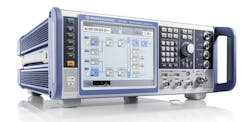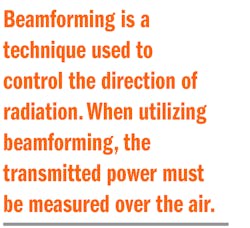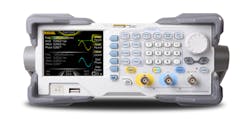Critical Talking Points in Test & Measurement
This file type includes high resolution graphics and schematics when applicable.
As wireless technology continues to invade our lives, suppliers of test-and-measurement equipment must keep up by offering the proper test solutions to meet today's needs. And the same suppliers must also think in terms of the future, with 5G obviously being on the minds of many. 5G and other applications are clearly setting the stage for even higher-frequency test solutions, which is currently a major focus of several suppliers. Today's other trends include compact, portable instruments that allow for flexibility while still delivering quality performance. Moreover, some other developments are worthy of attention as well.
With all of that being said, here are five recent—and potentially future—developments to take note of when it comes to high-frequency test and measurement:
1. Higher-Frequency Test Solutions
Delivering higher-frequency test solutions is clearly a high priority of a number of suppliers of test-and-measurement equipment today. There is no question that 5G is a major reason for this activity, with millimeter-wave frequencies being linked to 5G. However, other applications besides 5G are utilizing these higher frequencies, too. Automotive radar and IEEE 802.11ad, for example, both operate at millimeter-wave frequencies. Therefore, with the growing usage of millimeter-wave technology, test solutions must be available that can effectively satisfy higher-frequency requirements.
One company that is focused on providing millimeter-wave test solutions is Rohde & Schwarz. The company is at the forefront of 5G development, as proven by instruments like the SMW200A vector signal generator (VSG) and the FSW85 signal and spectrum analyzer (Fig. 1).
In addition, Rohde & Schwarz recently unveiled its NRPM over-the-air (OTA) power measurement solution, which covers frequencies ranging from 27.5 to 75 GHz. The NRPM OTA measurement solution is intended to test 5G, IEEE 802.11ad, and IEEE 802.11ay signals.
Beamforming is a technique used to control the direction of radiation. When utilizing beamforming, the transmitted power must be measured over the air. In addition, the actual beamforming performance needs to be verified. The NRPM measurement solution is designed to calibrate the transmit antenna output power and test the beamforming function.
The NRPM power measurement solution includes the NRPM-A66 single-polarized antenna module and the NRPM3 three-channel sensor module. The NRPM-A66 is a Vivaldi antenna with an integrated diode detector, which allows for power measurements. The NRPM3 processes the measured values from as many as three NRPM-A66 modules, and is connected to a PC by an interface cable.
For its part, Anritsu is also delivering higher-frequency test solutions. For instance, the company's MS2840A signal analyzer and MA2808A waveguide mixer can be used together, enabling measurements to be performed at E-band frequencies. This combination yields a phase noise at 79 GHz of -100 dBc/Hz at 10-kHz offset, making it well suited for automotive radar applications.
2. Better-Performing AWGs
Recently introduced arbitrary waveform generators (AWGs) are offering increased functionality, as suppliers are striving to meet a wide range of needs. For example, RIGOL Technologies recently expanded its DG1000Z series of function/arbitrary waveform generators by introducing the new DG1022Z model (Fig. 2). The DG1022Z provides users with a number of features, including eighth-order harmonic generation, support of various modulation types, and much more. "With the DG1022Z's built-in harmonic generation capability, engineers are able to test a wide array of filtering techniques," says Daniel Monforte, applications engineer at RIGOL Technologies.
The DG1000Z series utilizes RIGOL's SiFi technology, which allows true point-to-point arbitrary waves to be created. Monforte notes, "With our SiFi sampling technology, the DG1022Z creates complex arbitrary functions with ease and high signal fidelity, whether the goal is injecting a specific spectral noise profile or emulating baseband data. When paired with a RIGOL DSG3000 series RF source, the DG1022Z can be used to generate long series' of in-phase/quadrature (I/Q) modulated signals on a carrier. Hence, the DG1022Z enables testing of low-frequency RF modulation and emulation applications.
In addition to the new DG1022Z, the DG1000Z series consists of the DG1032Z and DG1062Z models. The DG1022Z has a maximum output frequency of 25 MHz for sine waves and square waves. Additionally, the DG1000Z series supports a number of modulation types, including amplitude modulation (AM), frequency modulation (FM), phase modulation (PM), amplitude shift keying (ASK), frequency shift keying (FSK), phase shift keying (PSK), and pulse-width modulation (PWM). The DG1000Z generators also contain a large number of built-in waveforms, allowing quick access to pre-defined signals.
Earlier in the year, Tektronix introduced its AWG4000 series waveform generation platform, which has two operation modes. The first is Basic mode, in which the AWG4000 operates as a two-channel arbitrary function generator (AFG). In this mode of operation, sine waves can be generated at frequencies as high as 600 MHz. In Advanced mode, the AWG4000 functions as an AWG with both analog and digital channels for complex waveform generation.
3. USB-Based Spectrum Analyzers
The spectrum analyzer has traditionally been a benchtop instrument. While traditional spectrum analyzers are not going to disappear anytime soon, several suppliers are now offering compact USB-based spectrum analyzers that possess their own advantages. Such instruments are particularly beneficial to meet the needs of the Internet of Things (IoT).
"The IoT is a primary driver in microwave and RF design today, and by extension a key driver in test-and-measurement instrumentation," says Matthew Maxwell, product manager of spectrum analyzers, Tektronix. “With the IoT comes exponentially increasing numbers of devices from thousands of manufacturers and a proliferation in wireless standards and proprietary protocols—more than 20 currently.
"We're seeing a growing need for engineers to have RF design experience—and the time-to-market windows keep shrinking," he adds. "Systems are being designed and built for a broad range of products, so test instrumentation versatility is vital."
Simply put, the increasing amount of IoT devices requires companies to have a larger number of test instruments. More test instruments obviously come at a large cost. However, Maxwell believes that USB-based spectrum analyzers can remedy the situation. In comparison to traditional instruments, USB-based instruments are a cost-effective solution for today's needs.
"Traditionally, RF experts shared expensive high-end equipment," he explains. "This was because few organizations could afford to buy more than one or two high-end instruments, and low-end signal analyzers lacked the necessary capabilities. This situation is now changing with the recent introduction of USB-based spectrum analyzers. USB-based RF test instruments possess fundamental advantages over their traditional desktop equivalents. In addition to signal capture circuitry, desktop spectrum analyzers must also include a full PC, adding considerable cost and complexity to the instrument.
"In contrast, the USB-based spectrum analyzer eliminates this cost from the instrument itself and simply takes advantage of the processing power sitting on the lab bench of every engineer or spectrum manager. USB-based instruments are controlled from PC-based software, and offer full real-time capture and advanced analysis capabilities in a compact package. In terms of price, organizations can now afford to buy 10 to 20 USB-based spectrum analyzers for the same price as one $50,000 or $100,000 instrument—and get similar analysis capabilities."
Among the USB-based spectrum analyzers currently offered by Tektronix is the RSA306B (Fig. 3). The RSA306B covers a frequency range of 9 kHz to 6.2 GHz and has an acquisition bandwidth of 40 MHz. Its portable package makes it well suited for use in the field, as well as factories and academic institutions.
4. PXI
PXI has been adopted by a number of manufacturers, allowing them to build scalable test systems. Of course, National Instruments (NI) is one company that is associated with PXI. Earlier this year, NI made headlines by unveiling its second-generation vector signal transceiver (VST), which offers as much as 1 GHz of instantaneous bandwidth.
Other players in the PXI space include Pickering Interfaces, which offers a range of RF/microwave PXI switch modules that cover frequencies as high as 65 GHz. The company recently introduced its new 60-104 two-slot chassis, which can support one or two 3U-high PXI switching modules. And earlier in the year, the company expanded its line of RF multiplexers with the introduction of the 40-760 series. This series of multiplexers covers frequencies ranging to 600 MHz.
5. A New Workflow
One additional point to take note of is not actually a trend in terms of current test-and-measurement equipment, but rather a potential change in regard to how test and design will be integrated in the future. According to Jack Sifri, MMIC/module design flow specialist at Keysight Technologies, "A dramatic shift is underway in the electronics design and test industry. Traditionally, a design flow has been pretty linear: Measure components and create models; use the models to design and simulate a circuit; then test the prototype. Each stage is separate and distinct."
As technology advances, Sifri believes the traditional workflow will change significantly. He adds, "We are headed toward a revolution, moving from the traditional flow toward one that will require an entirely new level of integration to design and verify the new systems of the future.
"The world is changing right in front of our eyes," he continues. "We see it in 5G, IoT, and modern radar systems. Instead of single channels, or even simple multiple input, multiple output (MIMO) configurations, the world is moving to massive phased array systems. Bandwidths have exploded from a few tens of MHz to multiple GHz. Carrier frequencies have moved from RF and low microwave to well into millimeter-wave. These technologies will change the way we work. Design and test are moving to an entirely new level of integration. These factors combine to break the traditional 'model, simulate, measure' flow that has served us so well in the past.”
Sifri believes that test will increase in complexity as the systems themselves become more complex. As a result, test-and-measurement will be more interwoven with the actual design process. He explains, "The most powerful compute farms simply will not have the horsepower to model the systems. As the systems become more complex, the tests that are needed to verify performance also become more complex. Applying modern computer science to this problem will dramatically reduce that time. Instead of designing test sequentially (and redundantly), simulation and measurement configurations will be driven by common databases. Thus, design will be even more inextricably connected with test. Our design/simulation software and test equipment provide a full solution for the engineering community to embrace this new design and test workflow."
Conclusion
To summarize, test-and-measurement suppliers are clearly focused on delivering new solutions to ever-advancing requirements. No doubt, delivering higher-frequency test solutions is a primary objective of some suppliers. 5G is playing a large role in these efforts, but other applications are utilizing higher frequencies as well. Both USB- and PXI-based instruments are heavily counted on, offering various benefits like cost, portability, and scalability. Lastly, technology advances have the potential to impact the overall role of test in future workflows. With all of this being said, it is clear that we can expect to continue seeing innovative test-and-measurement solutions.
This file type includes high resolution graphics and schematics when applicable.






